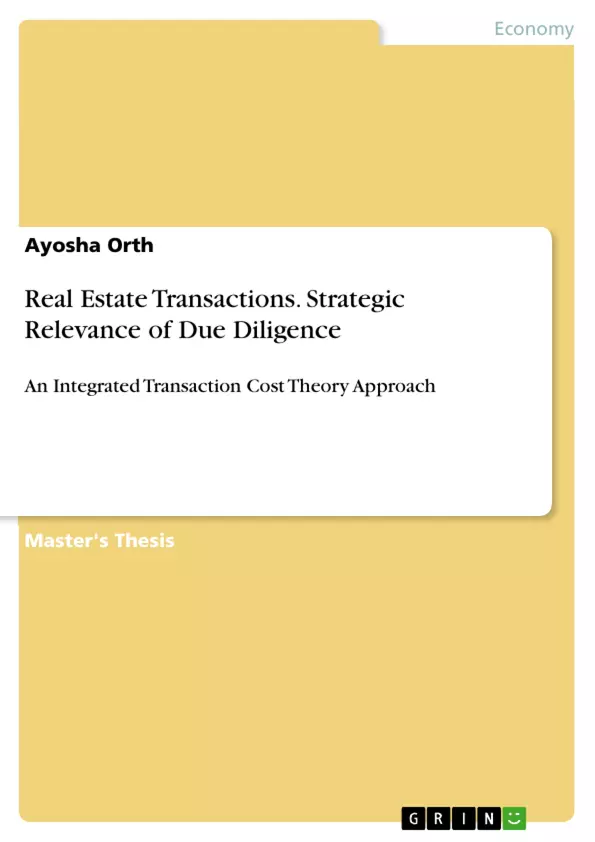The sub-prime mortgage crisis caused significant damage to the international real estate market. Did the crisis teach us anything? In practice, yes. For one, examinations in the form of due diligence of real estate assets have become more frequent and more thorough. Activities on the real estate market in Germany are recovering robustly and have almost reached precrisis levels. Thus, the practice of due diligence is increasing correspondingly.
However, the literature on due diligence real estate is still exiguous and lacks outright theoretic approaches. This thesis investigates the relevance of due diligence within real estate transactions by contextualizing it within integrated Transaction Cost Theory approaches and its behavioral assumptions. Transaction-cost and agency-theory parameters such as bounded rationality, opportunism and uncertainty offer approaches for describing how due diligence reduces information asymmetries, uncover hidden characteristics, and therefore prevent adverse selection. The conducted multi-method qualitative study affirms the strategic relevance of due diligence within real estate transactions.
Table 1 + 2 "anonymous expert interviews", therefore no content
Inhaltsverzeichnis (Table of Contents)
- Abstract
- Abstracto
- 1 Introduction
- 1.1 Research Question and Objectives
- 1.2 Structure of the Thesis
- 2 Theoretical Framework
- 2.1 Transaction Cost Theory
- 2.1.1 The Core of Transaction Cost Theory
- 2.1.2 The Concept of Bounded Rationality
- 2.1.3 Opportunism and Uncertainty
- 2.2 Information Asymmetry and Due Diligence
- 2.2.1 The Concept of Information Asymmetry
- 2.2.2 Due Diligence as a Countermeasure to Information Asymmetry
- 2.3 The Relevance of Due Diligence
- 3 Methodology
- 3.1 Research Design
- 3.2 Data Collection
- 3.3 Data Analysis
- 4 Empirical Findings
- 4.1 The Importance of Due Diligence in Real Estate Transactions
- 4.2 The Impact of Due Diligence on Transaction Costs
- 4.3 The Role of Due Diligence in Mitigating Risk
- 5 Discussion and Conclusion
- 5.1 Summary of Findings
- 5.2 Implications for Practice
- 5.3 Limitations and Future Research
- Bibliography
- Appendix
Zielsetzung und Themenschwerpunkte (Objectives and Key Themes)
This master thesis aims to investigate the strategic relevance of due diligence within real estate transactions. It examines how due diligence helps to mitigate information asymmetry and reduce transaction costs. The thesis uses an integrated Transaction Cost Theory approach to analyze the role of due diligence in mitigating risk and ensuring successful real estate transactions.
- Due diligence in real estate transactions
- Transaction Cost Theory and its application to real estate
- Information asymmetry and its implications for real estate transactions
- The role of due diligence in mitigating risk and reducing transaction costs
- The impact of due diligence on the success of real estate transactions
Zusammenfassung der Kapitel (Chapter Summaries)
- Chapter 1: Introduction This chapter introduces the research question and objectives of the thesis. It provides an overview of the sub-prime mortgage crisis and its impact on the real estate market. The chapter also outlines the structure of the thesis.
- Chapter 2: Theoretical Framework This chapter presents the theoretical framework of the thesis, focusing on Transaction Cost Theory and its application to real estate transactions. It examines the concepts of bounded rationality, opportunism, and uncertainty, as well as the role of information asymmetry and due diligence in mitigating these issues.
- Chapter 3: Methodology This chapter outlines the research design, data collection methods, and data analysis techniques used in the thesis. It explains how the research was conducted and how the data was collected and analyzed.
- Chapter 4: Empirical Findings This chapter presents the empirical findings of the research, focusing on the importance of due diligence in real estate transactions, its impact on transaction costs, and its role in mitigating risk. The chapter analyzes the results of the study and draws conclusions based on the data collected.
Schlüsselwörter (Keywords)
This thesis focuses on the strategic relevance of due diligence in real estate transactions. It explores the application of Transaction Cost Theory to understand how due diligence helps to mitigate information asymmetry and reduce transaction costs. Key concepts include due diligence, real estate, asymmetric information, transaction cost theory, hidden characteristics, uncertainty, and adverse selection.
- Quote paper
- Ayosha Orth (Author), 2015, Real Estate Transactions. Strategic Relevance of Due Diligence, Munich, GRIN Verlag, https://www.grin.com/document/299889



